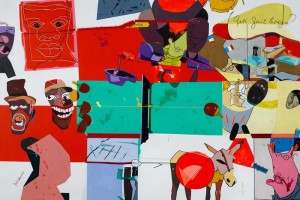
Hervé Télémaque, Centre Pompidou, Paris, until May 18, 2015
About:
With 75 works in the form of paintings, drawings, collages, objects and assemblages, the retrospective devoted to Hervé Télémaque (1937) is one of the most significant ever devoted to the Haiti-born French artist. It reveals for the first time at the Centre Pompidou all the diversity and consistency of a challenging body of work with undeniable visual power.

After spending three years in New York, where he became familiar with the abstract expressionism that influenced the assertive gestures of his first paintings, Télémaque settled in Paris in 1961. At this time, he became close to the Surrealist group. On canvas, he orchestrated the meeting of objects from consumer society and popular culture, which led to joyous visual short-circuits.

Soon a follower of the “clear line” style, Télémaque produced paintings with a strong autobiographical element. These were constructed as metaphorical sequences with a definite critical import, half-way between counter-culture and anti-colonialism, while exploring the complex relationship between image and language. However, between 1968 and 1970, the artist stopped painting to produce intriguing assemblages of objects, where the white stick, symbol of blindness, took on a major role.

When he returned to painting, Télémaque tackled collage for the first time, profoundly reworking its current techniques. During the Nineties, Télémaque also executed drawings in charcoal, whose dark forms and sophisticated cut-out effects dialogued with a large number of reliefs in salvaged wood covered with coffee grounds.

The 2000s were a period when he cast a fresh eye on the world, after returning to his African roots. His works at this time were notable for their frequent allusions to “negritude”, and their more precise comments on current French politics. In the middle of the decade, he made an unexpected and highly productive return to a striking new pictorial form. (text Centre Pompidou)
